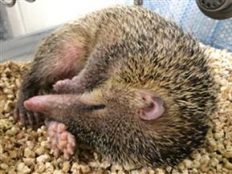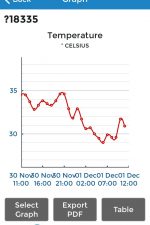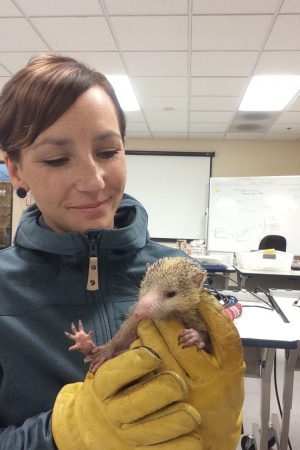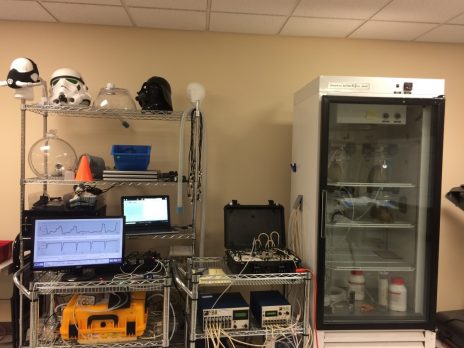What drives and what fuels thermogenesis in Malagasy common tenrecs?
– My trip to fabulous Las Vegas by Rebecca Oelkrug –

When I told people that I am going on a trip to Las Vegas, almost everyone replied, “Have fun gambling!” Well no, this wasn’t the purpose of my stay. I hate gambling and at that point was not even sure if I would like this loud, colorful, and busy city. So I started explaining that I am going to Las Vegas to work on Malagasy common tenrecs (Tenrec ecaudatus). In 99% of all conversations this statement was followed by the question, “Do tenrecs live in Las Vegas?” Of course they do not (although I kind of like this idea), tenrecs originally live in Madagascar but the Lab of Prof. Frank van Breukelen established a breeding colony in Las Vegas five years ago. And breeding tenrecs is a real pain in the neck… I tried it during my PhD without any success and ever since I am full of respect for everyone who has managed to breed a wild species in the lab. In the case of tenrecs it takes a lot of effort, patience, and the right intuition when a tenrec lady is in the mood to “cuddle” a tenrec guy. Just to give you some numbers, taking care of fifty rodents will maybe take you half a day, taking care of fifty tenrecs needs three student workers who take care of them six hours per day and seven days per week. And on top of that, tenrecs are hibernators, meaning that only ONCE per year after they come out of hibernation are they keen to reproduce. Well I think it is not necessary to say how much pressure this puts on your experimental schedule and how grateful you are for every born animal. So it is no wonder that I felt very lucky when Frank agreed to collaborate with me on this project.

Why is it so interesting to study thermogenesis in tenrecs? Tenrecs belong to the afrotherian clade, have many plesiomorphic traits, and may be representative of ancestral placental mammals. Furthermore, from a thermogenic point of view, they are considered as basoendothermic mammals because their body temperature regulation is not as tight as we know it from other more “modern” species (e.g. mice). Actually tenrecs show a quite flexible thermoregulatory behavior and frequently their body temperature tracks ambient temperature in reptilian-like patterns with a lowered maximum body temperature set-point (~32-34°C). For instance, T. ecaudatus allows its body temperature to follow ambient temperature to as low as 12°C even when being fully active, and even more strikingly, metabolic rate may vary 25-fold with little or no change in body temperature. Only during periods of reproduction is their body temperature maintained on a constantly high level, clearly demonstrating that tenrecs are able to control their endogenous thermogenesis. However, so far it is completely unknown on which source of endogenous heat production (shivering thermogenesis, non-shivering thermogenesis, or futile / metabolic cycles) T. ecaudatus relies on and which metabolic pathways contribute to body temperature maintenance.



To unravel the mechanism of endogenous heat production in T. ecaudatus, we used a pharmacological approach where tenrecs got injected with agonists (Norepinephrine, CL-316,243) and an antagonist (Propanolol) of the non-shivering thermogenesis pathway and a blocker for shivering thermogenesis (Dantrolene). Under physiological conditions, non-shivering thermogenesis is induced by the sympathetic nervous system which releases norepinephrine from nerve terminates that bind to β3-adrenergic receptors on the surface of brown adipocytes. The result of β3-adrenergic receptor activation by norepinephrine is an increase in lipolysis and heat production causing higher oxygen consumption rates, which we measured with a portable respirometry system for indirect calorimetry (FoxBox, Sable Systems). During my PhD I could already show in a smaller tenrec species, the Lesser hedgehog tenrecs (Echinops telfairi), that tenrecs express fully functional brown adipose tissue and accordingly I was quite convinced that injecting norepinephrine in T. ecaudatus would increase metabolic rate and body temperature or – in the worst case – would simply do nothing. BUT, I didn’t take into account that these are tenrecs… the strangest animals on earth and so it happened that some animals showed the opposite effect and even dropped their body temperature after norepinephrine injection?! Wow, I was puzzled; this must be “the unique metabolic flexibility” Frank and his Postdoc Michael were talking about? So I went straight to Frank´s office to talk to them and after telling the story they just looked at each other with this knowing expression in their eyes, shrugged their shoulders and said: “This is the stuff we’ve been dealing with for five years. Tenrecs are weird – right?” Yes, they are!



Although at this point I cannot tell you more about the results of this project, I want to give you more details on the equipment I’ve worked with. For the recording of body temperature, Frank’s Team uses Bluetooth data loggers which can be implanted into the abdominal cavity of the animals like the iButtons researchers frequently use in the field to record body temperature of free-ranging animals. The Bluetooth loggers have the big advantage that they can be re-programmed after implantation using an App, which extends battery life and allows the changing of measurement intervals and the download of data at any time. This makes work absolutely easier. Furthermore, for the metabolic chambers Frank’s lab uses storage containers which can be easily modified to airtight metabolic chambers. For my experiments we needed two different sets of chambers, which Frank just quickly put together – I was deeply impressed.
To additionally understand what fuels metabolic heat production in tenrecs, we collaborated with Dr. Marshall McCue from Sable Systems, who recently developed a novel metabolic chamber that allows the real-time measurement of stable isotopes – a minimally invasive and state-of-the art technique that promises high informative value. Therefore, animals were fed a diet infused with trace amounts of stable isotopically labeled amino acids (13C-leucine) or fatty acids (13C-palmitic acid) for two weeks prior to measurements. This feeding regime generated animals whose body proteins or lipids, respectively, were isotopically enriched, and by measuring the amount of 13C in their exhaled breath enabled us to calculate the number of fatty acid or amino acid tracers they were oxidizing after e.g. an injection with norepinephrine. A minimally invasive and highly sensitive method to estimate the metabolic fuel prioritization of an animal in various conditions and I was very happy, that I could learn how to use this new technology.


Overall, I had a great and very successful time in Las Vegas, and this thanks to the support of Frank, Michael, Marshall, Brandon and all the student workers who took care of me and the tenrecs. I thank the RCN for funding this exchange, Sable Systems for their equipment, and my boss in Lübeck, Prof. Jens Mittag, for giving me the opportunity to continue my tenrec research. Frank was the perfect host and I will try to adopt his way of handling guest scientists to our lab. And yes, in the end I enjoyed the city of Las Vegas and the surrounding area, and will definitely come back.



